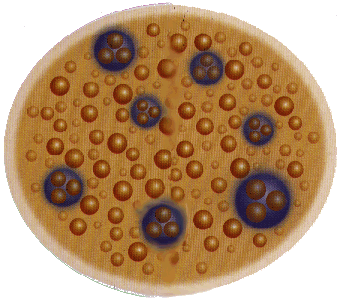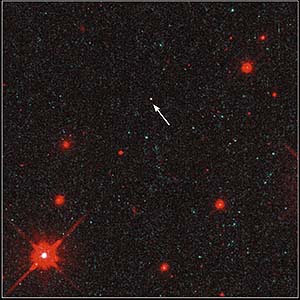 eutron stars are
formed out of the deaths of massive stars (several times larger than the
sun) so old they burned up all their nuclear fuel. Such stars throw off
their outer layers in the mighty explosions known as supernovas, leaving
only a core that is generally less than 10 miles in diameter but with
a density of hundreds of millions of tons per cubic inch. How dense is
that? A piece of neutron star the size of the period at the end of this
sentence would weigh about as much as the ill-fated ship, Titanic.
eutron stars are
formed out of the deaths of massive stars (several times larger than the
sun) so old they burned up all their nuclear fuel. Such stars throw off
their outer layers in the mighty explosions known as supernovas, leaving
only a core that is generally less than 10 miles in diameter but with
a density of hundreds of millions of tons per cubic inch. How dense is
that? A piece of neutron star the size of the period at the end of this
sentence would weigh about as much as the ill-fated ship, Titanic.
According to Berkeley Lab's Norman Glendenning, an internationally
recognized expert on compact stars, it is generally believed that quarks -- the
elementary particles that combine to form hadrons such as protons and
neutrons -- are liberated when matter is compressed to very high densities.

|
(Click on image to enlarge)
|
|
Pressure within the core of
a neutron star is thought to be so tremendous that nucleons (protons
and neutrons) burst apart like the popping of balloons. This sets free
the three quarks that combine to form each nucleon.
|
"A neutron star, because it is so dense, may be the only natural place
in the universe where quark matter exists," says Glendenning. "We may
have discovered a way of learning if this (the existence of free quarks)
is true."
Some neutron stars spin rapidly - several hundred rotations per second -- causing
them to send out regular pulses of radio signals that earned them the
name "pulsars." Radio signals from pulsars can be heard on Earth and
could be used to confirm some of the theories about the universe in
its earliest stages. Glendenning and his colleagues have postulated
that the presence of quark matter in pulsars should be detectable by
measuring their rates of spin. As pulsars age, their rotation slows.
This "spin-down" means a loss of outward-pushing centrifugal force,
which in turn means further compression of the pulsar's interior until
nuclear matter is crushed into quark matter.
"First at the center and then in an expanding region, the relatively
incompressible nuclear matter will be converted to the highly compressible
quark matter phase," says Glendenning. "This conversion to quark matter
(which has been likened to the consistency of soup) allows the pulsar
to rapidly shrink."
The pulsar's sudden reduction in size results in a "spin-up," much
like rotating ice skaters spin faster when they tuck their arms in close
to their bodies. For example, a pulsar spinning at 200 rotations per
second might, for a time, spin at 202 rotations per second.
| Lead scientist on this project
|
|
|
|
|
|
Glendenning and his colleagues estimate that converting the entire
core of a pulsar from nuclear to quark matter should take about 100,000
years. Since there are currently 700 known pulsars, this means that
about seven of them could be undergoing this transition now. Pulsar
observations are still in their infancy, and many of the known pulsars
were only recently discovered. Still, Glendenning and his colleagues
believe that spin-ups as a result of nuclear-quark phase matter transitions
are a very easy signal to detect and should be observable. The discovery
of such spin-ups would be momentous, they say.
"It would prove that the essentially free quark state predicted for
matter at very high energy densities actually exists," says Glendenning.
"The detection of this state would give us a picture of an early phase
of the Universe that is based on observation."
- Lynn Yarris



 eutron stars are
formed out of the deaths of massive stars (several times larger than the
sun) so old they burned up all their nuclear fuel. Such stars throw off
their outer layers in the mighty explosions known as supernovas, leaving
only a core that is generally less than 10 miles in diameter but with
a density of hundreds of millions of tons per cubic inch. How dense is
that? A piece of neutron star the size of the period at the end of this
sentence would weigh about as much as the ill-fated ship, Titanic.
eutron stars are
formed out of the deaths of massive stars (several times larger than the
sun) so old they burned up all their nuclear fuel. Such stars throw off
their outer layers in the mighty explosions known as supernovas, leaving
only a core that is generally less than 10 miles in diameter but with
a density of hundreds of millions of tons per cubic inch. How dense is
that? A piece of neutron star the size of the period at the end of this
sentence would weigh about as much as the ill-fated ship, Titanic.

